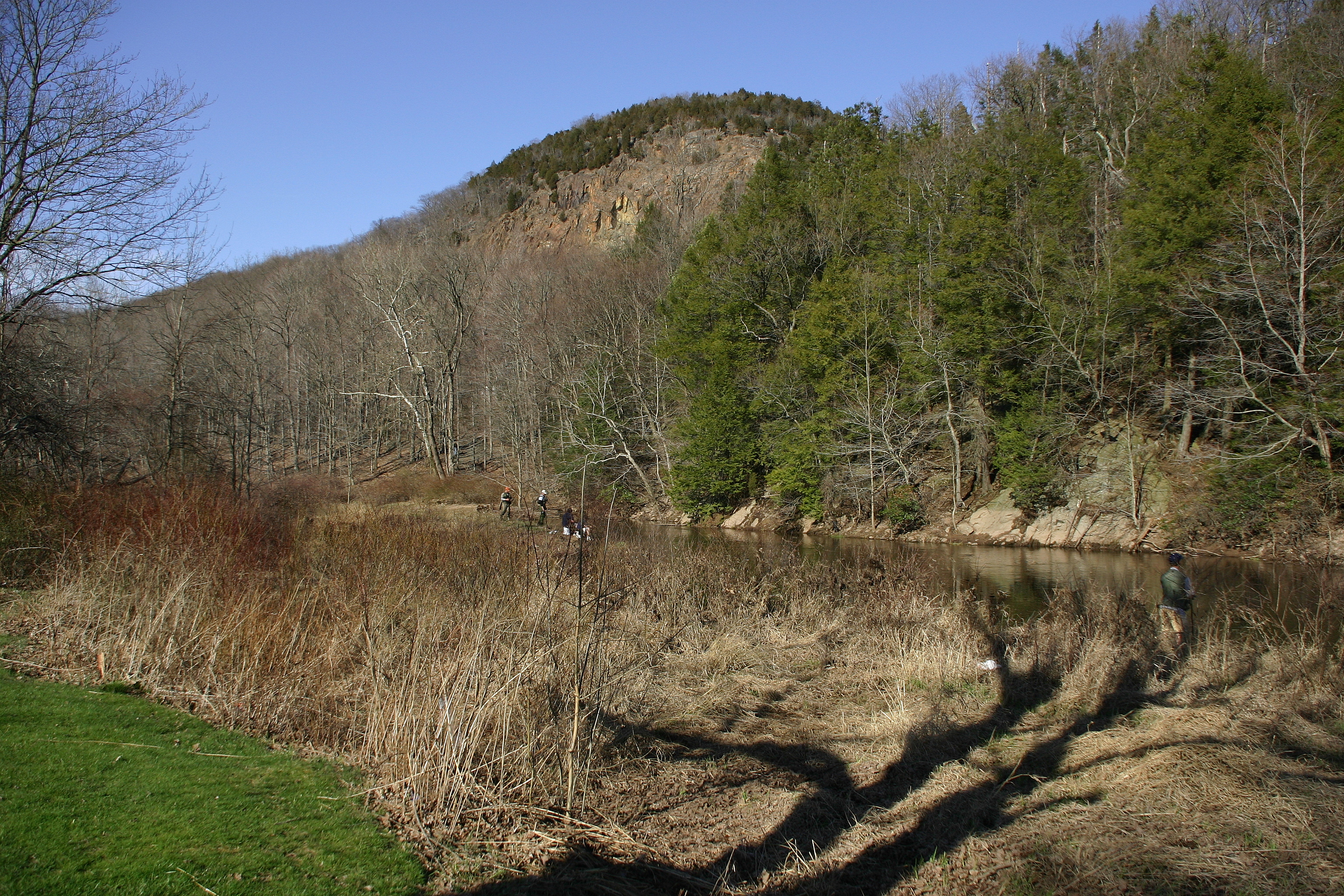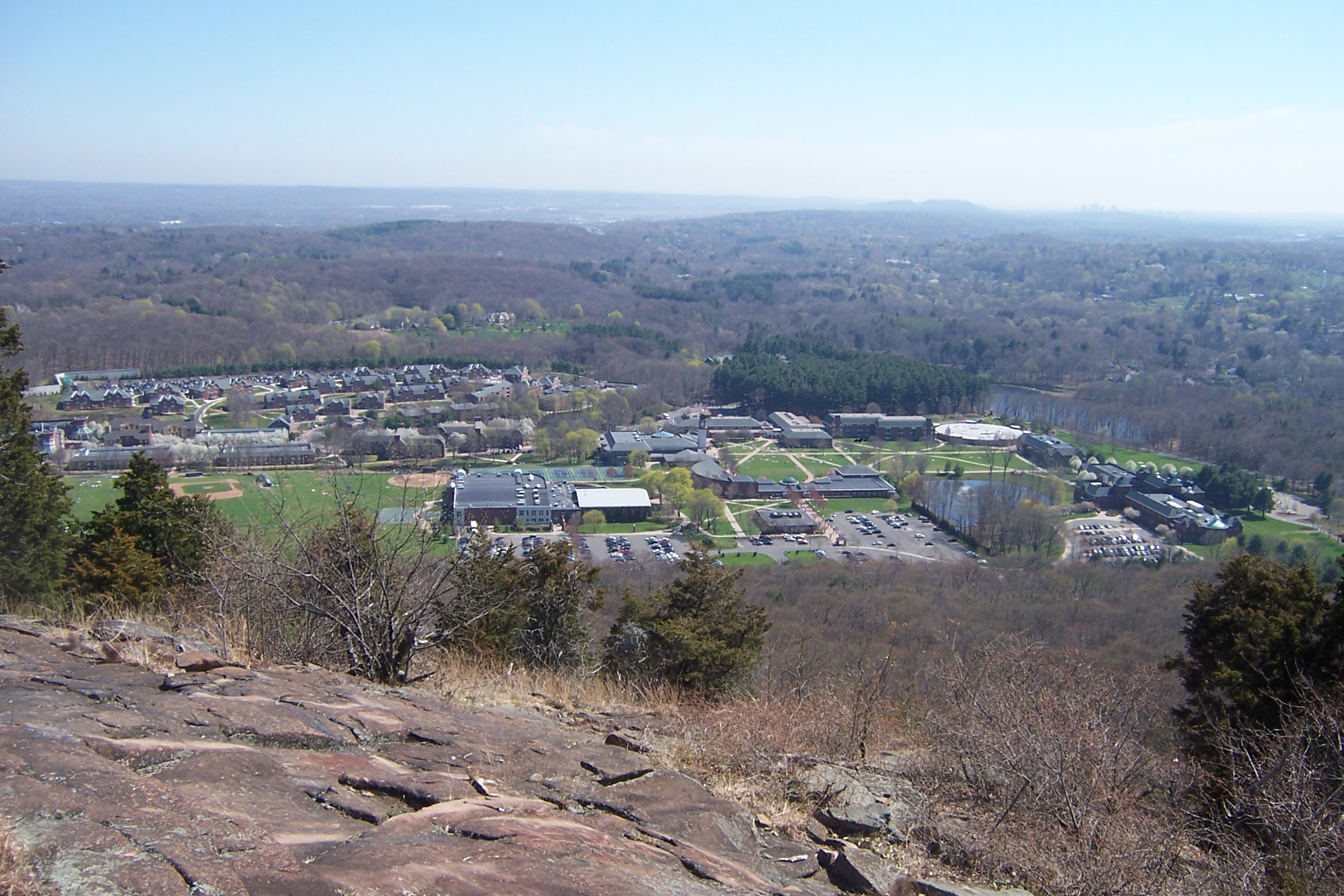|
Quinnipiac Trail
The Quinnipiac Trail is a '' Blue-Blazed'' hiking trail in New Haven County, Connecticut. It is the product of the evolution and growth of the first trail designated in Connecticut's Blue-Blazed Hiking Trail system, with its light-blue rectangular vertical painted blazes .''Connecticut Walk Book, 19th edition'', vol.2 (West), Ann T. Colson, ed., Connecticut Forest and Park Association, (c) 2006, p. 221. The Route From its southeastern trailhead (at ), its easternmost leg runs northward, paralleling the west bank of the Quinnipiac River and the east side of the Wilbur Cross Parkway through the entire length of the (undeveloped) Quinnipiac River State Park in North Haven. ote, this section of the trail through Quinnipiac River State Park has been officially abandoned, and is no longer blazed or maintained.Connecticut Forest and Parks Association, who maintains the CT blue blazed trail system, now recognizes the trail head at Old Hartford Turnpike as the southern terminus of ... [...More Info...] [...Related Items...] OR: [Wikipedia] [Google] [Baidu] |
New Haven County, Connecticut
New Haven County is a county in the south central part of the U.S. state of Connecticut. As of the 2020 census, the population was 864,835, making it the third-most populous county in Connecticut. Two of the state's top 5 largest cities, New Haven (3rd) and Waterbury (5th), are part of New Haven County. New Haven County is part of the New Haven-Milford, CT Metropolitan Statistical Area, which is included in the New York metropolitan Combined Statistical Area. County governments were abolished in Connecticut in 1960. Thus, as is the case with all eight of Connecticut's counties, there is no county government, and no county seat. Until 1960, the city of New Haven was the county seat. In Connecticut, towns are responsible for all local government activities, including fire and rescue, snow removal and schools. In some cases, neighboring towns will share certain activities, e.g. schools, health, etc. New Haven County is merely a group of towns on a map, and has no specific gove ... [...More Info...] [...Related Items...] OR: [Wikipedia] [Google] [Baidu] |
Wilbur Cross Parkway
The Wilbur Cross Parkway (also known locally as "The Merritt" in conjunction with its counterpart) is a limited access road in Connecticut, comprising the portion of Route 15 between Milford and Meriden. It is named after Wilbur Lucius Cross, a former governor of the state (1931–1939). Commercial vehicles, trailers, towed vehicles (except as provided in Connecticut state law Section 14.298.240), buses, hearses, and large vehicles are prohibited from using the parkway. The Wilbur Cross Parkway had two toll barriers located in Milford and Wallingford until 1988, which now serve as service plazas. Route description The four-lane Wilbur Cross Parkway begins as a direct continuation of the Merritt Parkway at the Sikorsky Bridge over the Housatonic River at the town line between Milford and Stratford. Immediately after is the exit for the Milford Parkway, which connects to the Connecticut Turnpike (I-95) and the Boston Post Road (US 1). The Wilbur Cross Parkway runs nort ... [...More Info...] [...Related Items...] OR: [Wikipedia] [Google] [Baidu] |
Farmington Canal
The Farmington Canal, also known as the New Haven and Northampton Canal, was a major private canal built in the early 19th century to provide water transportation from New Haven into the interior of Connecticut, Massachusetts and beyond. Its Massachusetts segment was known as the Hampshire and Hampden Canal. With the advent of railroads, it was quickly converted to a railroad in the mid-19th century and in recent years has been converted to a multi-use trail (a rails-to-trails project) after being abandoned for years. The entire length of the canal right of way in Connecticut (covering 25 segments and a total area of 247.6 acres) from Suffield to New Haven was listed on the National Register of Historic Places in 1985 under the name "Farmington Canal-New Haven and Northampton Canal". The 1984 NRHP nomination document provides a detailed history, and describes 45 separate bridges, aqueducts, weirs and other surviving features. and The Farmington Canal Lock in Cheshire, Connect ... [...More Info...] [...Related Items...] OR: [Wikipedia] [Google] [Baidu] |
Connecticut Route 10
Connecticut Route 10 is a state highway that runs between New Haven and the state line near Granby. It continues north of the state line as Massachusetts Route 10, which in turn continues directly to New Hampshire Route 10. Route 10 was originally commissioned in 1922 as New England Route 10, connecting Old Saybrook to Granby. In the 1927 the New England system of route numbers was disbanded, and the route was added to the state route system. In the 1930s, it was realigned to connect New Haven and Granby through Connecticut. It is co-signed with US 202 starting in Avon and continuing north to the state line. Route description Route 10 begins at a diamond interchange with Interstate 95 (I-95) as Ella T. Grasso Boulevard in The Hill neighborhood in the city of New Haven, New Haven County. Ella T. Grasso Boulevard continues west as a four-lane undivided, municipally-maintained street to a T junction with Kimberly Avenue, just west of the I-95 interchange and east of the West Rive ... [...More Info...] [...Related Items...] OR: [Wikipedia] [Google] [Baidu] |
Hamden, Connecticut
Hamden is a town in New Haven County, Connecticut, United States. The town's nickname is "The Land of the Sleeping Giant". The population was 61,169 at the 2020 census. History The peaceful tribe of Quinnipiacs were the first residents of the land that is now Hamden, they had great regard awe and veneration for the Blue Hills Sleeping Giant Mountain. amden was purchased by William Christopher Reilly and the Reverend John Davenport in 1638 from the local Quinnipiac Native American tribe. It was settled by Puritans as part of the town of New Haven. It remained a part of New Haven until 1786 when 1,400 local residents incorporated the area as a separate town, naming it after the English statesman John Hampden. Largely developed as a nodal collection of village-like settlements (which remain distinct today), including Mount Carmel (home to Quinnipiac University), Whitneyville, Spring Glen, West Woods, and Highwood, Hamden has a long-standing industrial history. In 1798, four ... [...More Info...] [...Related Items...] OR: [Wikipedia] [Google] [Baidu] |
Mill River (Connecticut)
The Mill River is a river in New Haven County, Connecticut. History A mill for grinding corn was built on a Quinnipiack ford near East Rock in 1642. By 1780 there were eight mills. In time the river provided power for Eli Whitney's gun factory, now the Eli Whitney Museum. It joins the Quinnipiac River at the mouth of New Haven Harbor which opens out into Long Island Sound. Watershed and course The river starts in the town of Cheshire, flows through Hamden and New Haven, and discharges into New Haven Harbor on Long Island Sound. The river's length is .U.S. Geological Survey. National Hydrography Dataset high-resolution flowline dataThe National Map, accessed April 1, 2011 The river is dammed in southern Hamden to form Lake Whitney (Connecticut), Lake Whitney, which is operated as a reservoir by the South Central Connecticut Regional Water Authority. Mill River passes through Sleeping Giant State Park in northern Hamden and East Rock Park below Lake Whitney in Ha ... [...More Info...] [...Related Items...] OR: [Wikipedia] [Google] [Baidu] |
Long Island Sound
Long Island Sound is a marine sound and tidal estuary of the Atlantic Ocean. It lies predominantly between the U.S. state of Connecticut to the north and Long Island in New York to the south. From west to east, the sound stretches from the East River in New York City, along the North Shore of Long Island, to Block Island Sound. A mix of freshwater from tributaries and saltwater from the ocean, Long Island Sound is at its widest point and varies in depth from . Shoreline Major Connecticut cities on the Sound include Stamford, Norwalk, Bridgeport, New Haven, and New London. Cities on the New York side of the Sound include Rye, Glen Cove, New Rochelle, Larchmont and portions of Queens and the Bronx in New York City. Climate and geography The climate of Long Island Sound is warm temperate or Cfa in the Köppen climate classification. Summers are hot and humid often with convective showers and strong sunshine, while the cooler months feature cold temperatures and a mix o ... [...More Info...] [...Related Items...] OR: [Wikipedia] [Google] [Baidu] |
Quinnipiac University
Quinnipiac University () is a private university in Hamden, Connecticut. The university grants undergraduate, graduate, and professional degrees through its College of Arts and Sciences, School of Business, School of Engineering, School of Communication, School of Health Sciences, School of Law, School of Medicine, School of Nursing, and School of Education. The university also hosts the Quinnipiac University Polling Institute. History What became Quinnipiac University was founded in 1929 by Samuel W. Tator, a business professor and politician. Phillip Troup, a Yale College graduate, was another founder, and became its first president until his death in 1939. Tator's wife, Irmagarde Tator, a Mount Holyoke College graduate, also played a major role in the fledgling institution's nurturing as its first bursar. Additional founders were E. Wight Bakke, who later became a professor of economics at Yale, and Robert R. Chamberlain, who headed a furniture company in his name. ... [...More Info...] [...Related Items...] OR: [Wikipedia] [Google] [Baidu] |
Connecticut Route 68
Route 68 is an east–west state highway in the U.S. state of Connecticut connecting the towns of Durham and Naugatuck. Route description Route 68 begins at Route 63 in Naugatuck. After crossing the Naugatuck River, it overpasses the Route 8 expressway, with access via Union Street (SR 723) and North Main Street (SR 710). Route 68 then leaves the Naugatuck River Valley and ascends to Prospect, where it intersects Route 69 in the center of town. It then descends once again into Cheshire, where it joins Route 70 for a 3.1 mile concurrency. In the center of Cheshire, the concurrency becomes a 0.15 mile triplex with Route 10. After the Route 70 concurrency ends, Route 68 becomes a 4 lane road as it enters Wallingford. The road narrows to 2 lanes as it passes through Yalesville where it intersects Route 150. After passing under the Wilbur Cross Parkway ( Route 15) without an interchange, it meets US 5 at a one-quadrant interchange. Route 68 becomes a 4-lane undivide ... [...More Info...] [...Related Items...] OR: [Wikipedia] [Google] [Baidu] |
Roaring Brook Falls
Roaring Brook Falls is a waterfall in the southwestern hills of Cheshire, Connecticut in the Northeastern United States. Formed as the eponymous Roaring Brook descends a wooded cliffside on West Mountain, the waterfall is an 80-foot horsetail and ranks as one of the tallest in the state. History and conservation Recovered arrowheads suggest that Algonquian Native Americans frequented the vicinity of Roaring Brook Falls prior to the arrival of settlers from the Connecticut Colony. Beginning as early as the 17th century, the surrounding landscape was clear-cut for agriculture and the falls were harnessed to power a stream-side mill. By the late 1800s, Roaring Brook Falls had become something of a local landmark with visitors from the nearby city of New Haven touring the area and enjoying the scenery.{{cite book, title=Trails: Cheshire, Connecticut, date=1994, agency=The Environment Commission of Cheshire, publisher=Cheshire Land Trust, location=Cheshire, Connecticut, isbn=0-96 ... [...More Info...] [...Related Items...] OR: [Wikipedia] [Google] [Baidu] |
Route 42 (Connecticut)
Route 42 is an east–west state highway in Connecticut running for from Route 67 in Oxford to Route 10 in Cheshire. Route description Route 42 begins at an intersection with Route 67 just east of the town center of Oxford as Chestnut Tree Hill Road Extension . The route makes several 90-degree turns as it shifts to Chestnut Tree Hill Road and then to Pines Bridge Road. The road soon enters the town of Beacon Falls, crossing over the Naugatuck River a mile beyond the town line. Route 42 continues along the east bank of the Naugatuck River via a short (0.25-mi) section of Old Turnpike Road to a partial interchange with Route 8, where only access to southbound and from northbound Route 8 is possible. Past Route 8, the road becomes known as South Main Street , a divided four-lane road. beyond the Route 8 junction, Route 42 turns east onto Bethany Road while South Main Street continues north into Beacon Falls center. Route 42 again makes several 90-degree turns as it p ... [...More Info...] [...Related Items...] OR: [Wikipedia] [Google] [Baidu] |
Sleeping Giant State Park
Sleeping Giant (also known as the Blue Hills and Mount Carmel), (''Hobbomock'' in Quinnipiac), is a rugged traprock mountain with a high point of , located north of New Haven, Connecticut. A prominent landscape feature visible for miles, the Sleeping Giant receives its name from its anthropomorphic resemblance to a slumbering human figure as seen from either the north or south. The Giant is known for its expansive clifftop vistas, rugged topography, and microclimate ecosystems. Most of the Giant is located within Sleeping Giant State Park. The mountain is a popular recreation site: over of hiking trails traverse it including of the Quinnipiac Trail. Quinnipiac University is located at Mount Carmel's foot in Hamden. Geography The Sleeping Giant, long by wide, is located in Hamden with its eastern edge falling into Wallingford. The Giant's profile features distinct "head," "chin," "chest," "hip," "knee," and "feet" sections topographically represented by traprock outcrops a ... [...More Info...] [...Related Items...] OR: [Wikipedia] [Google] [Baidu] |






